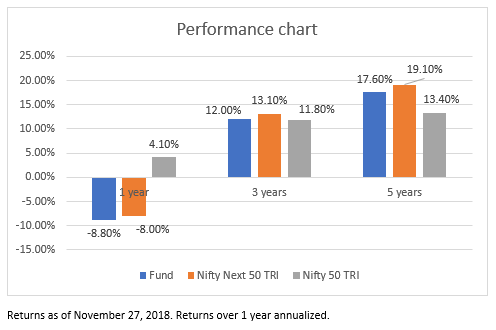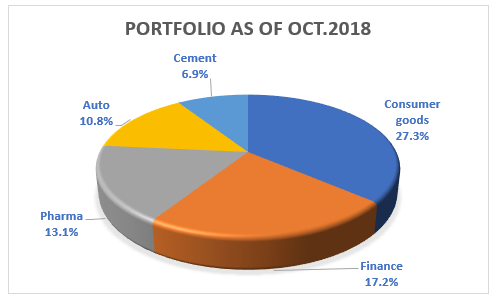SEBI defines the top 100 stocks as the large-cap universe for mutual funds to invest in. You know about the top 50 – nested in the bellwether index Nifty 50. These are the largest of large companies in the market. What if you could own the next 50 – the emerging super-large companies but with enough legroom for growth unlike the giants? This set of stocks built as an index – called the Nifty Next 50 (earlier called the Junior Nifty) – has delivered superior returns. And here’s how this index is better than the narrow 50 index and also better than a diversified 100 index.
| Performance | Nifty 50 TRI | Nifty 100 TRI | Nifty Next 50 TRI |
|---|---|---|---|
| % of times the index beat large-cap funds when 3-year returns were rolled daily in the past 5 years | 24% | 35% | 96% |
| Average rolling 3 year returns in the past 5 years (CAGR) | 12.4% | 13.7% | 19.6% |
| Portfolio | Nifty 50 TRI | Nifty 100 TRI | Nifty Next 50 TRI |
| % to top 3 sectors | 65.7% | 60% | 58.2% |
| % to top 5 stocks | 37.6% | 32.7% | 20.1% |
The data above will tell you a few things:
- The Next 50 index is a high performer and it serves as a sweet spot between the narrow 50 and the wide 100 stocks.
- The sweet spot stems from acting as an incubator for stocks of companies that make the leap to the top.
- Similarly, the index is sometimes like a catchment zone for temporarily mispriced stocks in the top 50 that fall as a result of correction.
- The index is far more diversified in terms of sectors and stock holdings. It does not have high weight to the largest mover of the Nifty 50 – banking and financial services. And yet, it has delivered better.
Unlike traditional indices, this index has put out a noteworthy show. So why is it that it that we have not discussed much about it as an investment idea until now? One, other than Reliance Junior BEES ETF, there were not many options for a retail investor. Even this index suffered from lower volumes traded. From less than 10,000 securities traded per day in 2016, it is now over 30,000 a day. ETFs are also available only if you have a demat/brokerage account.
Two, index funds, built on this index, (from ICICI and IDBI) have also been around for some years now but both not only had tiny AUMs but high tracking error (return deviation from the index). This has been improving now with the ICICI Pru Next 50 index fund. The more recently launched ones (like UTI) must be watched for tracking error.
Aside of availability of an index fund, the third reason why this index is not easy to recommend for everybody is its high volatility and inability to contain downsides. For example, even over a 3-year period (rolling basis) the worst return for this index was a negative 1.2%. The same was 1.1% for the Nifty 50 and 0.86% for the Nifty 100.
This essentially means it is not a perfect substitute for a passive large-cap index or an active large-cap fund. At best, it can be an addition to the multi-cap category of funds you may hold. What is good about it is its ability to outperform many actively managed funds – a feat rarely achieved in the Indian context.
The fund
ICICI Pru Nifty Next 50 index fund was launched in 2010 to track the Nifty Next 50. Its AUM, however, did not cross Rs 100 crore until late 2017.
The fund’s returns record has seen significant improvement in the past 3 years when compared with large-cap funds and with multi-cap and large &mid categories. The outperformance is partly to do with the active large-cap category also struggling to beat their benchmarks in recent times. While the fund is technically an index for large caps, comparing it with the multi-cap fund space would be a prudent way to assess performance.
Performance
ICICI Pru Nifty Next 50 index fund beat 28 out of the 30 large-cap funds on a rolling 1-year return basis over the last 3 years. Its returns, though, swung significantly from its average (measured by standard deviation) compared with most large-cap funds.
Over the same period, the fund also beat most of the diversified funds (including value, focused, contra and dividend yield) barring about 6 of them, most of which are in FundsIndia’s researched list of funds. Some of the noteworthy outperformers include Mirae Asset India Equity, Invesco India Contra and Motilal Oswal Multicap 35.
 However, the fund’s longer record was more chequered, and it also deviated significantly from its index performance. For example, the fund’s 3-year return differential with its index was as high as 2 percentage points over 2015 and 2016. Besides, the fund outperformed the multi-cap category average only 64% of the times if we look at its 3-year rolling returns over the last 5 years.
However, the fund’s longer record was more chequered, and it also deviated significantly from its index performance. For example, the fund’s 3-year return differential with its index was as high as 2 percentage points over 2015 and 2016. Besides, the fund outperformed the multi-cap category average only 64% of the times if we look at its 3-year rolling returns over the last 5 years.
The data above suggests few things: one, the outperformance of the index per se has been more pronounced in recent times, thanks to lower weight to banks. Two, the fund, both due to high tracking error and low AUM deviated more from its index in earlier years and has improved in the last 2 years. Three and importantly, actively managed funds may slip in the short term (1 year) but still outperform in the long run.
At this point, therefore, the fund may not be a good substitute for good multi-cap funds. It can work well as an addition to your portfolio, especially given that it holds lower bank exposure compared with most multicap funds.
The fund’s tracking error is also still high when compared with a Sensex or Nifty 50 index fund. The only reason to hold this fund inspite of high tracking error is that it still manages to beat a good section of the large and diversified fund universe.
Portfolio
The most distinguishing feature of the Next 50 index is its low exposure to financial services – at 17.2% as of October 2018. There are no finance stocks in the top 10 holdings. The ones that are present come from insurance and NBFCs, with just a couple of banks. This has to do with the fact the top banks are too large to find a place other than in the top 50 and the rest, thanks to the rout in the sector, have dropped below the top 100. Without excessive weight to banks the portfolio therefore has more diversified holding across sectors such as consumer, pharma, auto, cement, metals and capital goods. Quality, high growth companies clearly find a place in the index.

ICICI Pru Next 50 index had an AUM of Rs 301 crore and expense ratio of 0.85% as of October 2018.
FundsIndia’s Research team has, to the best of its ability, taken into account various factors – both quantitative measures and qualitative assessments, in an unbiased manner, while choosing the fund(s) mentioned above. However, they carry unknown risks and uncertainties linked to broad markets, as well as analysts’ expectations about future events. They should not, therefore, be the sole basis for investment decisions. To know how to read our weekly fund reviews, please click here.








What is the recommended percentage of this fund can be in overall portfolio. For instance if an investor already has Large cap,Mid and Multicap fund in the portfolio
Hello,
As mentioned, this fund can get volatile. The allocation to the fund would depend on what you already hold, in what proportion and your risk level.
Thanks,
Bhavana
Hello,
As mentioned, this fund can get volatile. The allocation to the fund would depend on what you already hold, in what proportion and your risk level.
Thanks,
Bhavana
What is the recommended percentage of this fund can be in overall portfolio. For instance if an investor already has Large cap,Mid and Multicap fund in the portfolio
Hello,
As mentioned, this fund can get volatile. The allocation to the fund would depend on what you already hold, in what proportion and your risk level.
Thanks,
Bhavana